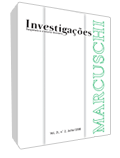Como se constroem e reconstroem os objetos-de-discurso
Abstract
O trabalho trata inicialmente das várias formas de introdução, no texto, dos objetos-de-discurso, para, em seguida, discutir os processos de categorização e recategorização de tais objetos, buscando ampliar reflexões anteriores sobre esse tema. Será demonstrado que as expressões nominais são fundamentais nos processos de construção, categorização e recategorização dos objetos-de-discurso, sendo em grande parte responsáveis pelo desenvolvimento do tópico discursivo.References
AUTHIER, J. 1981. Paroles tenues à distance. In: CONEN, B. et al. Matérialités discursives. Actes du Colloque des 24-26, avril 1980, Paris X, Nanterre, Presses Universitaires de Lille.
CARVALHO, M. A. F. 2005. O funcionamento textual-discursivo dos rótulos em artigos de opinião. Tese de Doutorado em Lingüística. Campinas: IEL/Unicamp.
CONSTEN, M.; KNEES, M. 2008. Complex Anaphors in Discourse. In: SASSEN, C.; BENZ, A.; KÜHNLEIN, P. (eds.). Constraints in Discourse. Amsterdam: J. Benjamins, p. 181-199.
CONSTEN, M.; KNEES, M; SCHWARZ-FRIESEL, M. 2007. The Function of Complex Anaphors in Texts. In: SCHWARZ-FRIESEL, M.; CONSTEN, M.; KNEES, M. (eds.). Anaphors in Texts: Cognitive, Formal and Applied Approaches to Anaphoric reference. Harcover: J. Benjamins.
CONSTEN, M.; MARX, K. 2006. Komplex Anaphern — Rezeption und textuelle Funktion. In: BLÜDHORM, H.; BREINDL, E.; HERMANN, U. (orgs.). Text Verstehen: Grammatic und darüber hinaus. Berlin: Walter de Gruyter.
CONTE, E. 1966. Anaphoric Encapsulation. Belgian Journal of Linguistics: Coherence and Anaphora, vol.10, pp.1-10.
FRANCIS, G. 1994. Labelling discourse: an aspect of nominal-group lexical cohesion. In: M. Coulthard (ed.), Advances in written text analysis. London: Routledge.
KLEIBER, G. 2001. L’anaphore associative. Paris: PUF.
______; SCHNEDECKER, C.; UJMA, L. 1994. L’anaphore associative: d’une conception à l’autre. In: SCHNEDECKER, C.; CHAROLLES, M.; KLEIBER, G. DAVID, J. (orgs). L’Anaphore associative. Paris: Kliencksieck, p. 5-64.
KOCH, I. G. V. 2004. Introdução à Lingüística Textual: Trajetória e grandes temas. São Paulo: Martins Fontes.
______. 2002. Desvendando os segredos do texto. São Paulo: Cortez.
______. 2007. A estratégia metadiscursiva da rotulação. CD-room do VII Congresso Latinoamericano de Estudios del Discurso: “Horizontes do Sentido”, Universidad Nacional de Colômbia, Bogotá, pp.536-542.
______. 1999. Referenciação: Construção discursiva. Ensaio apresentado por ocasião do concurso para Titular em Análise do Discurso do IEL/UNICAMP.
______.; MARCUSCHI, L. A. 1998. Processos de referenciação na produção discursiva. D.E.L.T.A ., vol.14, no. especial, p.169-190.
MARCUSCHI, L. A.; KOCH, I. V. 2002 [1998]. Estratégias de referenciação e progressão referencial na língua falada. In: ABAURRE, M. B. (org.). Gramática do Português Falado, vol. VIII, Campinas: Edunicamp.
______. 2007 [2003]. Atividades de referenciação, inferenciação e categorização na produção do sentido. In: MARCUSCHI, L. A. Cognição, Linguagem e Práticas Interacionais. Rio de Janeiro: Lucerna, Série Dispersos.
MONDADA, L.; DUBOIS, D. 1995. Construction des objets de discours et catégorisation: une approche des processus de référentiation. In: A.Berrendonner & M-J. Reichler-Béguelin (op. cit.), p.273-302.
MONDADA, L. 1994. Verbalisation de l’espace et fabrication du savoir: approche linguistique de la construction des objets du discourse. Lausanne, Université de Lausanne.
MÜSSELER, J.; RICKHEIT, G. 1990. Inferenz — und Referenz - Prozesse in der Textverarbeitung. In: FELIX, S.; KANNGIESSER, R. (eds.). Sprache und Wissen.Studien zur kognitiven Linguistik. Opladen: Westdeutscher Verlag, pp.71-98.
PRINCE, E. 1981. Toward a taxonomy of given-new information. In: COLE, P. (ed.). Radical Pragmatics, New York, Academic Press.
SCHUTZ, A. 1970. Reflections on the problem of relevance. New Heaven: Yale University Press.
Downloads
Published
How to Cite
Issue
Section
License
Copyright (c) 2008 Ingedore G. Villaça Koch

This work is licensed under a Creative Commons Attribution 4.0 International License.
Authors who publish with Revista Investigações agree to the following terms:
Authors retain copyright and grant the journal right of first publication with the work simultaneously licensed under the Creative Commons Attribution 4.0 International (CC BY 4.0) license that allows others to share the work with an acknowledgement of the work's authorship and initial publication in this journal.
Authors are able to enter into separate, additional contractual arrangements for the non-exclusive distribution of the journal's published version of the work (e.g., post it to an institutional repository or publish it in a book), with an acknowledgement of its initial publication in this journal.
You are free to:
Share — copy and redistribute the material in any medium or format for any purpose, even commercially.
Adapt — remix, transform, and build upon the material for any purpose, even commercially.
The licensor cannot revoke these freedoms as long as you follow the license terms.
Under the following terms:
Attribution — You must give appropriate credit , provide a link to the license, and indicate if changes were made . You may do so in any reasonable manner, but not in any way that suggests the licensor endorses you or your use.
No additional restrictions — You may not apply legal terms or technological measures that legally restrict others from doing anything the license permits.

